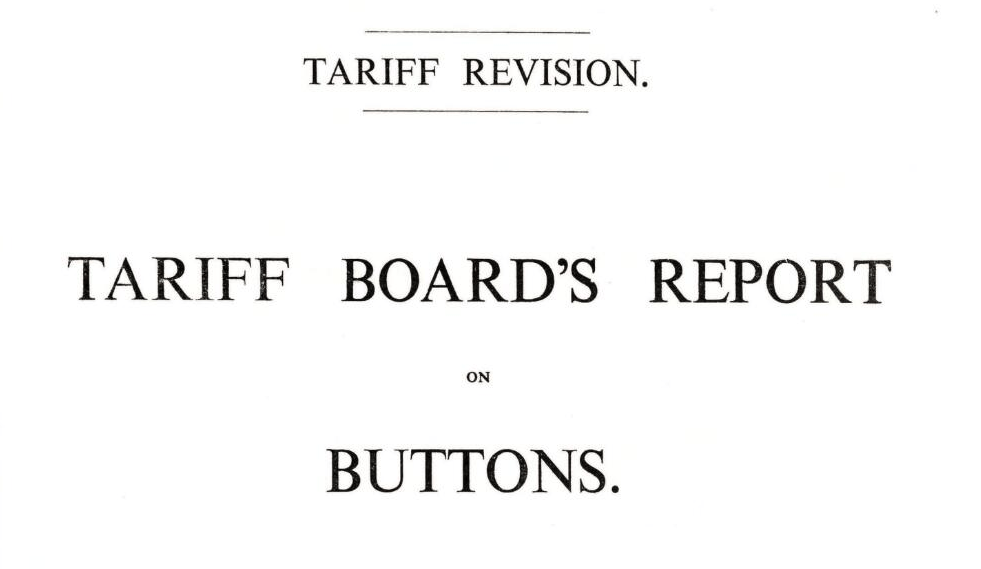
From Trove: TARIFF REVISION. TARIFF BOARD’S REPORT ON BUTTONS.
1st AUGUST, 1958. (Printed for) THE PARLIAMENT OF THE COMMONWEALTH OP AUSTRALIA
How exciting! An inquiry into tariffs on buttons!
In June 1957 the Minister for Trade set up an inquiry into whether assistance in the way of tariffs for button production (including that of ‘blanks’ and finishing of partially finished buttons) should continue, and if so, under what rates of duty on imported goods.
Speaking in favour of protection, not surprisingly, were the manufacturers. These representatives of General Plastics Ltd, Bijou Button & Buckle Pty. Ltd., Stokes & Sons Pty. Ltd., Carr Fastener Co. of Australia Ltd, G. Herring (Aust.) Pty. Ltd. and Peerless Plastics. J. G. Lloyd was mentioned. Only Peerless is a surprise as they manufactured plastic dolls from Cheltenhem, Victoria. They were supplying small casein buttons for knitwear.
Speaking against protection, not surprisingly, were importers ( including P. F. Davies mentioned yesterday). Councils for Australian retailers and for British Button manufacturers also spoke against duties.
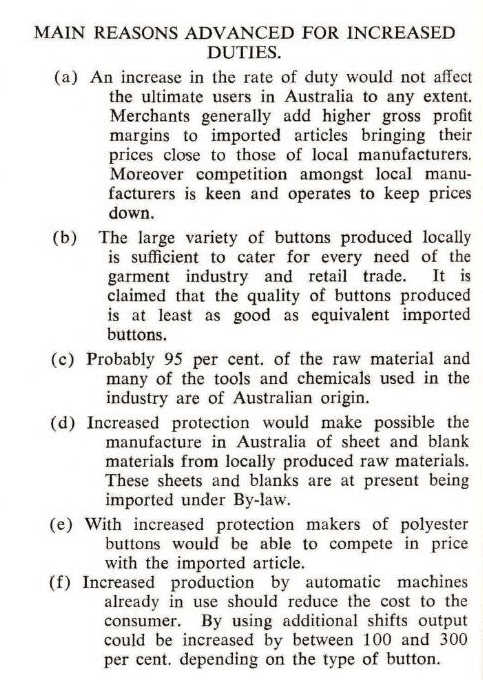
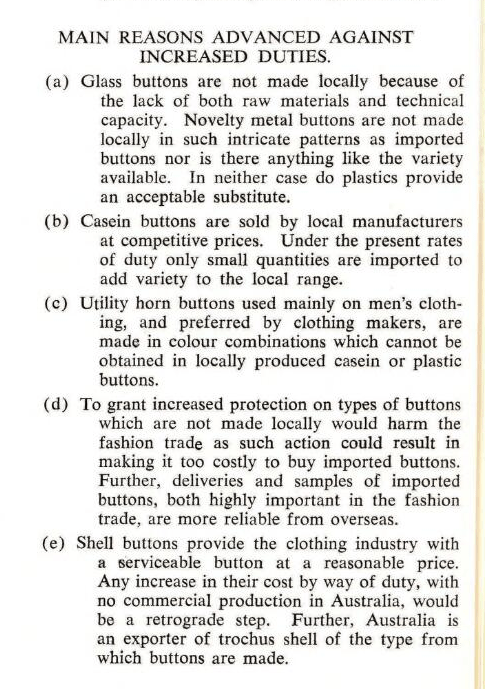
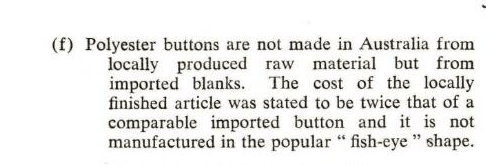
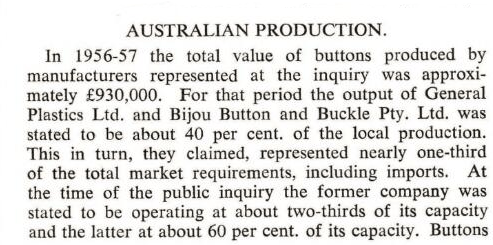
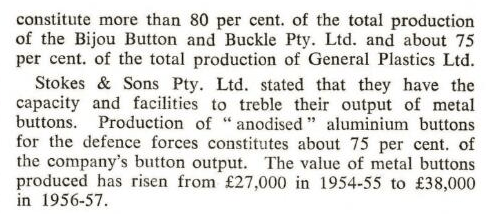
The table below shows the proportion, not the actual amounts, of buttons made and imported into Australia, using locally manufactured casein buttons as 100 on the scale.

Wood, corozo, and horn buttons made up a very small proportion. Australian-made casein, plastic buttons, as well as imported polyester buttons, made up the bulk, with lesser amounts of imported shell and locally made metal buttons.
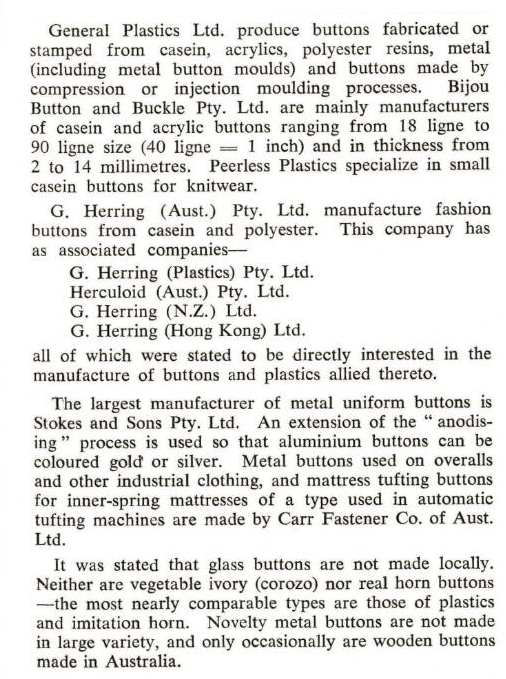
EXPORTING
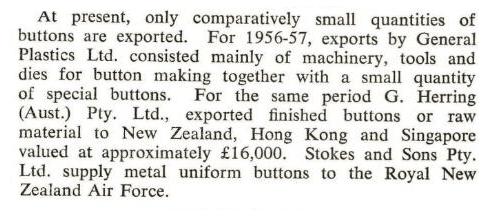
IMPORTING
For the three years prior to this report, imports of buttons from Hong Kong and Japan had increased considerably, and partly at the expense of British manufacturers.
DEMAND
Local production of pearl buttons had ceased. About 90 percent of the previous demand for shell buttons was now met by imitations (plastics). There was no local production of glass buttons. These were imported in “considerable quantities”.
In terms of value, the demand was the same, although the quantity consumed had increased. This was due in part to mechanisation and increased efficiency (read less workers employed). People engaged directly and indirectly in button production had fallen from around 1,000 in 1952 to 249 in 1957 and was still decreasing. Much of the increase in consumption was being met by cheap imported buttons, especially from Kong Kong and Japan. “Considerable quantities” of casein in the form of sheets and blanks, and polyester blanks from Hong Kong, Japan and Italy, were imported.
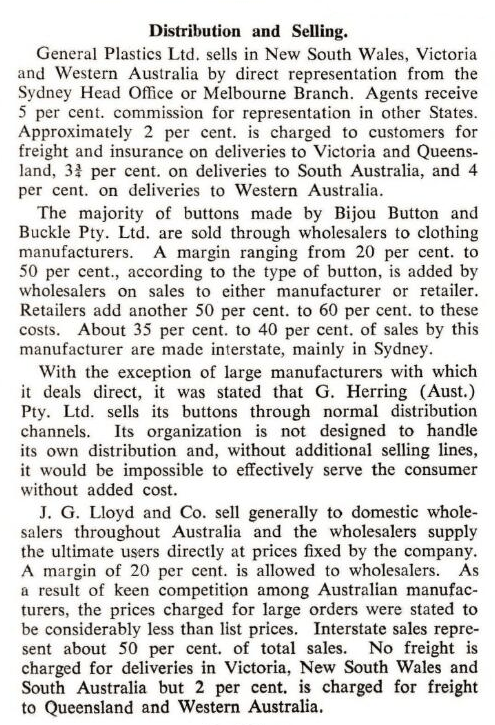
Costs of production were higher in Australia, mostly due to the much higher wages paid here compared with Britain and Asia. Interestingly, the proportion of women employed in Britain was higher. (They were paid less than men both in Britain and Australia). Manufacturers claimed the quality of their products was at the least equal of imported buttons, that capacity existed to increase production to completely meet local demand, and that there were acceptable Australian made substitutes for those types of buttons not made locally. On this last point, the Board of Inquiry was not entirely convinced.
However, the board accepted that the local industry was “reasonably efficient”, but faced higher material and labour costs. It concluded that the industry was worthy of protection against overseas competition. Utility plastic and casein buttons compared favourably in quality and price, but not so acrylic and polyester. It was admitted that it was not economical to produce every type or style of button within Australia, and that it was reasonable to import a variety of novelty and fashion items. The most significant threat to the Australian industry was from imitation pearl shell buttons imported from Hong Kong, Japan, and to a lesser degree, Italy.

Due to the increasing cheapness of producing and importing polyester blanks and finished buttons, it was suggested that a new tariff be introduced to cover imitation shell, polyester, casein and other synthetic buttons. With regards to blanks, it was suggested these have a lower rate of tariff than buttons, as local manufacturers were using these to make finished buttons. Horn and corozo buttons were diminishing in importance and competitiveness for the local clothing industry. Stokes & Sons, the largest metal button manufacturer in Australia, was requesting the current 17.5 percent tariff not be reduced, which made the request of General Plastics and others for a 47.5 percent tariff unjustifiable. The council did suggest 22.5 for British and 35 percent for “Most Favoured Nations”.
If you wish to access the complete report: https://nla.gov.au/nla.obj-2772284962/view?partId=nla.obj-2775492965#page/n0/mode/1up
